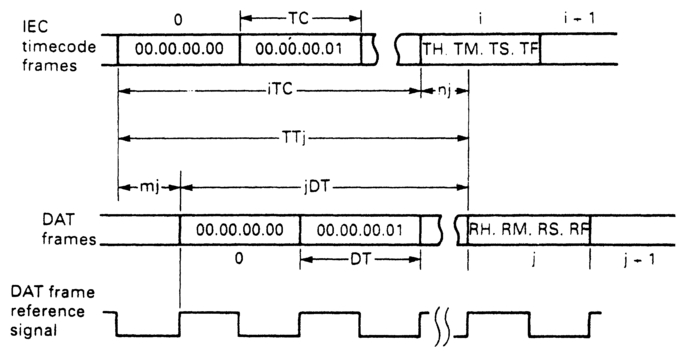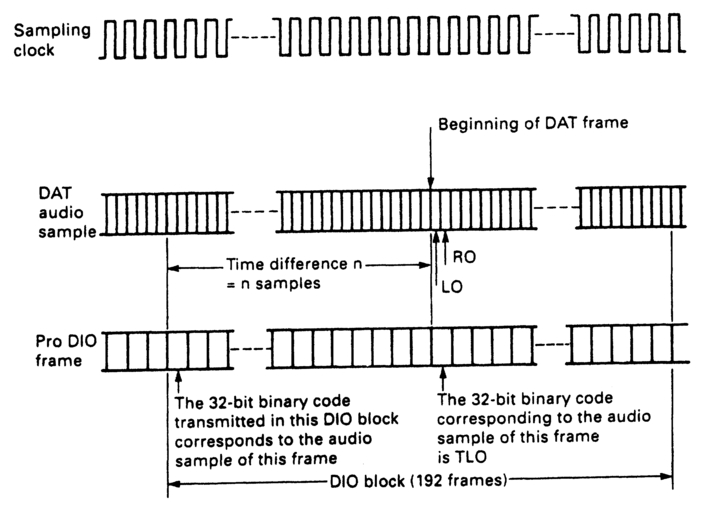Appendix 3
Timecodes conversion
A To convert from IEC timecode to Pro-R time (Figure A3.1):

Figure A3.1 IEC timecode and DAT frame timecode conversion factors illustrated.
- TH = Hours stored in the ith IEC timecode frame TM = Minutes stored in the ith IEC timecode frame TS = Seconds stored in the ith IEC timecode frame TF = Frames stores in the ith IEC timecode frame TC = period of timecode frame DT = period of DAT frame nj = time difference between the start of the jth DAT frame and the start of the IEC timecode frame current at the start of the jth DAT frame TTj = time of the IEC timecode frame current at the start of the jth DAT frame mj = time difference between TTj and jDT Tfs = periodic time of sampling clock used for the IEC timecode conversion from the IEC timecode to the Pro-R time TCM = timecode marker, which expresses time difference in terms of Tfs
- TC, DT, nj, TTj, mj & Tfs are expressed in the same units
The relationship between EBU, SMPTE or Film (24 fps) timecode and ProR time is as follows:
The R time and the TC marker identify the time of the IEC timecode at the start of a DAT frame reference signal, the period of which corresponds to a group of audio data recorded on a positive azimuth track, and the following negative azimuth track. A DAT frame is identified by the DAT Frame Reference Signal, as defined below.
- TTj = nj + iTC
- j = INT (TTj/DT)
- = 120000RH + 2000RM + 33RS + INT(RS/3) + RF
- mj = TTj MOD (mj/Tfs)
where
- j = total number of DAT frames from zero up to the start of a DAT frame
- i = total number of IEC timecode frames from zero up to the start of the IEC timecode frame current at the start of the jth DAT frame
- For EBU timecode,
- i = 90000TH + 1500TM + 25TS + TF
- For SMPTE drop-frame timecode,
- i = 107892TH + 1798TM + 21NT(TM/10) + 30TS + TF
- For SMPTE non drop-frame,
- i = 108000TH + 1800TM + 30TS + TF
- For 24 fps film,
- i = 86400TH + 1440TM + 24TS + TF
To convert from Pro-DIO code to Pro-R time (Figure A3.2):
Pro-DIO code is recorded in the Pro-R time pack as a 32-bit binary code, transmitted over the Channel 1 sub-pack. The conversion obeys the following rules:
- TLQ = TB + n where
- TLO = the 32-bit binary code corresponding to the 1st sample (LO) of a DAT frame
- TB = the 32-bit binary code in the channel status data of the DIO block current at the start of the DAT frame
- n = time difference (unit:sample) from the start of the DIO block to the start of the DIO frame
To convert from TLO (32-bit binary) to Pro-R time:
- Sample number = TLO MOD(DTs)
- where DTs = number of audio samples in one DAT frame
- If Fs = 48 kHz then DTs = 1440 (0–1439)
- If Fs = 44.1 kHz then DTs 1323 (0–1322)
- If Fs = 32 kHz then DTs = 960 (0–959)
Hours (RH), Minutes (RM), seconds (RS), and frames (RF), recorded in packs PC4 to PC7 are recorded in 2 digit BCD form. The following ranges apply:

Figure A3.2 Sampling clock, DAT audio samples and ProDIO frame sequences compared.
- RH, 00-99
- RM, 00-59
- RS, 00-59
- RF, 00-33 (if RS MOD 3 = 2); 00-32 (if RS MOD 3 = 1 or 0).
- k = INT(TLO/ DTs) MOD 100
- RF = k MOD(33) + 33 INT(k/99)
- RS = 3[INT(TLO/lOODTs) MOD 20] + INT(k/33) - INT(k/99)
- RM = INT(TLO / 2000DTs) MOD 60
- RH = INT (TLO / 120000DTs)
D Conversion from Pro-R time to TLO (32 bit binary)
TLO = [12000RH + 2000RM + 33RS + INT(RS/3) + RF] × DTs + Sample number
Conversion between IEC timecode and ProDIO code (Figure A3.3).
The conversion from IEC timecode to ProDIO code, the 32-bit code, (TLO) corresponding to the 1st audio sample (LO) of a DAT frame, is calculated as followed:
TLO = [120000RH + 2000RM + 33RS + INT(RS/3) + RF] × DTs + TC marker
To convert from ProDIO code to IEC timecode, let the start of the zero frame IEC code (00h 00m 00s 00f) correspond to all zeros of the 32-bit binary code (TLO), Then the relationship between TLO and TTj is:

Figure A3.3 IEC timecode frame, ProDIO block and R-DAT frame conversion factors compared.
